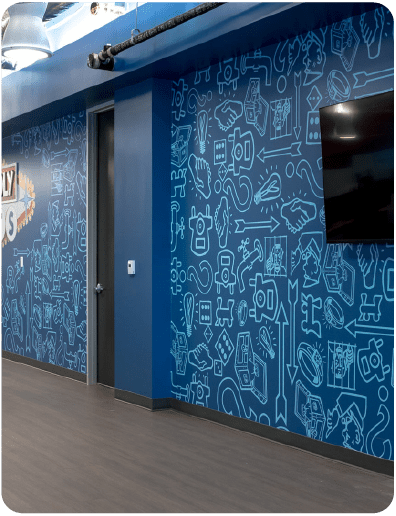
Why Wall Decals Don’t Stick
Wall decals are a popular, non-permanent way to personalize indoor spaces in schools, offices, or homes. They’re easy to apply and visually impactful. But sometimes, customers face a frustrating issue: the decals simply won’t stick.
One of the most common reasons is a dirty or dusty wall. It’s crucial to clean the surface thoroughly before applying any decal. Another issue is freshly painted walls in these cases, it’s best to wait at least two weeks for the paint to fully cure.
Decals also struggle to adhere to walls painted with low-VOC or zero-VOC paints, which often repel adhesives. Extreme temperatures during installation too hot or too cold can cause the material to fail. And if you’re trying to install decals on rough or textured surfaces, there may not be enough smooth contact for proper adhesion.
If you’re wondering how to get wall decals to stick, the key lies in surface preparation and selecting high-quality materials.
Clean and Dry the Surface Properly
Proper wall preparation is essential for decal success. Start by cleaning the wall with isopropyl alcohol or a solution of warm water and mild soap. Use a lint-free cloth and make sure to remove all dust, oil, and invisible residues that could interfere with the adhesive.
Avoid using harsh cleaners like bleach, ammonia, or other abrasive chemicals. These can leave behind a film that weakens adhesion or worse, damage the wall surface.
Wait After Painting: Timing Is Critical
If your wall was recently painted, it’s crucial to wait 4 to 8 weeks before applying any wall decals. While some paints may feel dry to the touch within hours, that doesn’t mean they are fully cured.
Even so-called “quick-dry” or “low-odor” paints may continue to release volatile organic compounds (VOCs) for several weeks. These VOCs interfere with adhesive bonding and may cause decals to peel off prematurely.
Choose the Right Material for Your Environment
Vinyl vs. Fabric Decals
Choosing the right material is critical to the success of your wall graphic installation. The two most common types are adhesive vinyl and self-adhesive fabric.
Vinyl decals are durable, water-resistant, and offer a sleek, professional finish. They’re perfect for smooth interior walls in spaces like offices, schools, or retail environments. For larger and visually impactful applications, a vinyl wall wrap is the ideal solution to cover entire walls with stunning custom designs.
On the other hand, fabric decals are softer, easier to reposition, and typically remove cleanly without damaging the paint. They perform better on lightly textured walls or surfaces painted with low-VOC paints, which can otherwise reduce adhesive strength. Fabric is also more forgiving when dealing with curved or uneven surfaces.
Use Heat to Activate Adhesive
One of the most effective tricks to ensure a wall decal sticks properly is using heat. A hair dryer set to medium or hot can be used to gently warm the wall surface before applying the decal. This softens the paint and the adhesive for better bonding.
After application, you can reapply heat with the hair dryer and use pressure to help the vinyl settle. Heat activates the adhesive, making it more flexible and increasing its grip on the surface—especially useful in cooler environments or on lightly textured walls.
Use the Right Tools: Squeegees and Tapes
Another critical part of successful application is using the right tools. Painter’s tape is perfect for positioning your decal on the wall before peeling the backing. This ensures proper alignment without commitment.
Once the decal is placed, use a squeegee or plastic scraper to apply even pressure from the center out. This eliminates air bubbles and helps the decal bond smoothly to the wall.
What To Do If Your Decal Starts Peeling
Even with proper preparation, decals can sometimes lift or peel—especially around the edges. Don’t panic. Start by gently peeling back the loose section and cleaning the area underneath with isopropyl alcohol. Allow it to dry fully.
Next, use a hairdryer on a low heat setting to warm the adhesive. Heat activates pressure-sensitive adhesives, helping them bond better. Press firmly with a squeegee or clean cloth as you reapply.
Still not sticking? Use a repositionable adhesive spray designed for wall art, like Aleene’s Tack-It Over & Over or Gorilla Spray Adhesive. Apply sparingly and only to the decal’s back, not the wall. These products provide temporary hold without damaging surfaces.
Avoid using permanent glues—they may damage your wall during future removal.
If you’re dealing with highly textured walls or low-VOC paints, consider switching to fabric decals. They often perform better under these conditions and can be repositioned easily.
Edges Peeling? How to Reattach Without Damage
A common issue with wall decals is peeling edges, especially in corners or textured areas. To fix this safely:
- Gently lift the peeling edge using your fingernail or a plastic tool.
- Use a hair dryer on medium heat to warm the area for a few seconds.
- Press the decal back down firmly with a squeegee or soft cloth, smoothing outward.
This technique reactivates the original adhesive. But if the problem continues or the adhesive is no longer effective, consider using removable adhesives such as:
- Gorilla Repositionable Spray Adhesive
- Elmer’s CraftBond Repositionable Glue Stick
- Krylon Easy-Tack Repositionable Adhesive
Use Removable Adhesive Glues Carefully
These products are great for last-resort fixes or temporary solutions. However, to avoid damage:
- Apply glue only to the back of the decal, never directly on the wall.
- Test a small area first to ensure it doesn’t stain or peel paint.
- Use sparingly to prevent buildup or permanent marks.
These adhesives are effective for emergency fixes, but best results always start with proper prep and installation.
Surfaces Where Wall Decals Don’t Work
While wall decals can stick well to many surfaces, there are certain environments where they simply won’t work effectively no matter how well you prep the surface.
Common problem surfaces include:
- Unpainted brick: Its uneven, porous texture offers poor adhesive contact.
- Rough concrete: Like brick, it lacks the smoothness needed for decals to bond securely.
- Heavy textures with peaks: Such as “orange peel” or “knockdown” wall finishes that interfere with full adhesion.
In these situations, consider applying your graphics to smoother surfaces, like commercial or interior doors. This is where door stickers in Austin become a perfect solution. Doors offer a flat, clean, and consistent surface, ideal for branding, wayfinding, or decorative designs that need to last.
The success of any decal doesn’t depend only on the design it also depends on where you place it. Choose the right surface, and your message will stick — literally.
At Sign Depot, we understand that even the best wall decals don’t last forever. If the adhesive becomes dry, contaminated, or loses its grip, it’s a sign the decal is beyond saving. Faded colors, warping, or peeling edges are also strong indicators that it’s time for a refresh — not just for appearance, but for your brand’s professionalism.
That’s when upgrading to fresh vinyl decals in Austin is the smart move. We use premium materials designed for long-term use, vivid print quality, and excellent adhesion.
Custom Decals for Difficult Surfaces
Some surfaces just aren’t decal-friendly — but that doesn’t mean your message can’t shine. We specialize in custom designed graphics that adapt to your space’s specific challenges. Instead of forcing a standard decal, we’ll create one that works.
One great solution? Our door decals in Austin. These are perfect for high-traffic entryways, office doors, or interior surfaces where durability and clarity matter most. Every decal is crafted to match your space, purpose, and style.
At Sign Depot, we help you replace, upgrade, and rethink your visual environment beautifully and professionally.
Contact Information
- Address: 12110 Manchaca Rd. Suite 200, Austin, TX, 78748
- Email: wecare@signdepotatx.com
- Phone: 512 219 8000
- Follow us:
 Facebook
Facebook
 Instagram
Instagram
Why Choose
Custom Murals
How to Choose the
Right Artist in Austin, Texas
Types of Custom
Murals Available
The Creative Process
Behind a Custom Mural
Inspiration for
Your Next Project
COMPLETE THE FORM
CHECK OUR WORK
FAQ’S
Why don’t my wall decals stick properly?
Common causes include dirty or dusty walls, freshly painted surfaces that haven’t fully cured, low-VOC paints that repel adhesives, extreme temperatures during installation, or rough and heavily textured walls.
How should I prepare my wall before applying decals?
Clean the surface with isopropyl alcohol or mild soap and water, make sure it’s fully dry, and wait at least 4–8 weeks after painting before installation to ensure proper adhesion.
Which materials work best for long-lasting wall decals?
Vinyl decals are durable, water-resistant, and ideal for smooth indoor walls, while fabric decals are repositionable, remove cleanly, and perform better on lightly textured or low-VOC painted surfaces.
What techniques help wall decals stick better?
Use painter’s tape to align the decal, a squeegee to apply even pressure, and a hair dryer to gently heat the surface activating the adhesive and improving grip, especially in cooler or textured environments
How can I fix peeling edges on wall decals?
Reheat the area with a hair dryer and press it back down with a squeegee. If adhesion is still weak, apply a removable glue like Gorilla Repositionable Spray or Elmer’s CraftBond, but always test a small area first.
Find Us in Austin, Texas
12110 Manchaca Rd. Suite 200 Austin, TX, 78748
Email: wecare@signdepotatx.com
Phone: 512 219 8000




